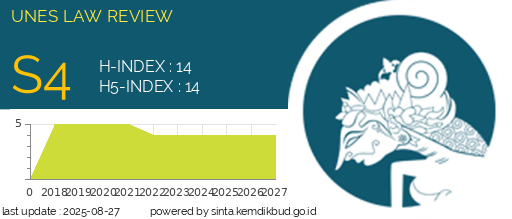Tinjauan Yuridis Kedudukan Amicus Curiae Terhadap Anak Pelaku Pelecehan Seksual
Keywords:
Children as Perpetrators, Sexual Harassment, Amicus CuriaeAbstract
Children as child offender who is not yet 18 years old has been suspected of commiting a criminal act. A criminal act sexual harassment is a crime that is often committed by minors in the form of ex pressions, actions until physical intercourse. So that in this case the concept of “amicus curiae” can help examine and clarify the case of a child perpetrator of sexual harassment in proving a crime. In this studyiaimsutoideterminelthe mechanismsof “amicus curiae” position towards children as perpetrators of sexual harassment and the research method used was normative research method or research using literature study by examing primaryllegalsmaterials, secondary legal materialsand tertiaryylegalsmaterials. So that thehresult ofithis study indicatesthataposition of “amicus curiae” in a criminal act as evidence can be in writing and not in writing. “Amicus Curiae” if it is linked to evidence of article 184 KUHAP ofrthe criminalkproceduremcode, “amicus curiae” can be classified in material evidencetof letter and intructions but not formally. And the concept of amicus curiae canihelp examine and clarify the juvenite criminal justice process as a perpetrator of sexual harassment who is studied from a philosophical, sociological, and juridical perspective by providing a basis for consideration to the judge related to a child perpetrators of sexual harassment and this case the judge can use the concept of a amicus curiae in deciding the sentence for a child perpetrators of sexual abuse by putting forward the best principles for Children without sacrifing children’s rights.
Downloads
References
Jamba, Padrisan, Darlisma Darlisma, Ragil Surya Prakasa, Yoan B Runtunuwu, Grace Kelly Hadi Putri Sihombing, Anna Andriany Siagian, Riki Zulfiko, Lola Yustrisia, Sukmareni Sukmareni, and Irwansyah Irwansyah. Pengantar Hukum Acara Pidana Indonesia. Jakarta: CV. Gita Lentera, 2023.
Krisnalita, Louisa Yesami, Mutiarany Mutiarany, Grace Sharon, and Ani Munirah Mohamad. “The Legal Position of Amicus Curiae’s Opinion on Criminal Judicial Processes in Indonesia.” Justitia Jurnal Hukum 6, no. 1 (2022). https://doi.org/https://doi.org/10.30651/justitia.v7i1.12807.
Malik, Rizal Hussein Abdul, Antonius Sidik Maryono, and Pramono Suko Legowo. “Penerapan Amicus Curiae Dalam Pemeriksaan Perkara Di Pengadilan Negeri Tanggerang.” Soedirman Law Review 4, no. 2 (2022). http://journal.fh.unsoed.ac.id/index.php/SLR/article/view/189.
Mohan, S Chandra. “The Amicus Curiae: Friends No More.” Sing. J. Legal Stud., 2010, 352.
Nurhayati, Yati, Ifrani Ifrani, and M Yasir Said. “Metodologi Normatif Dan Empiris Dalam Perspektif Ilmu Hukum.” Jurnal Penegakan Hukum Indonesia 2, no. 1 (2021): 1–20. https://doi.org/https://doi.org/10.51749/jphi.v2i1.14.
Prasetyo, Andik. “Perlindungan Hukum Bagi Anak Pelaku Tindak Pidana.” Mizan: Jurnal Ilmu Hukum 9, no. 1 (2020): 51–60. https://doi.org/https://doi.org/10.32503/mizan.v9i1.1054.
Rahmadi, Anak Agung Gde, and I Nyoman Budiana. “Amicus Curiae Dalam Pembuktian Perkara Pidana Di Pengadilan.” Jurnal Kertha Semaya 9 (2021). https://doi.org/https://doi.org/10.24843/KS.2021.v09.i02.p12.
Suryandi, Dody, Nike Hutabarat, and Hartono Pamungkas. “Penerapan Sanksi Pidana Terhadap Pelaku Tindak Pidana Kekerasan Seksual Terhadap Anak.” Jurnal Darma Agung 28, no. 1 (2020): 84–91. https://doi.org/http://dx.doi.org/10.46930/ojsuda.v28i1.464.
Downloads
Published
How to Cite
Issue
Section
License
Hak cipta :
Penulis yang mempublikasikan manuskripnya di jurnal ini menyetujui ketentuan berikut:
- Hak cipta pada setiap artikel adalah milik penulis.
- Penulis mengakui bahwa UNES Law Review berhak menjadi yang pertama menerbitkan dengan lisensi Creative Commons Attribution 4.0 International (Attribution 4.0 International CC BY 4.0) .
- Penulis dapat mengirimkan artikel secara terpisah, mengatur distribusi non-eksklusif manuskrip yang telah diterbitkan dalam jurnal ini ke versi lain (misalnya, dikirim ke repositori institusi penulis, publikasi ke dalam buku, dll.), dengan mengakui bahwa manuskrip telah diterbitkan pertama kali di Jurnal UNES Law Review.


















